The German Navy in WWI
 Hochseeflotte and Kaiserliches Marine 1890-1918
Hochseeflotte and Kaiserliches Marine 1890-1918
The Hochseeflotte, literally “High Seas Fleet”, was the main battle fleet, part of the larger Kaiserliches Marine (lt. “Imperial Navy”), instrument of Kaiser Wilhelm II, well served by Grand Admiral Von Tirpitz, to secure and keep a colonial empire and to defiantly oppose the major traditional naval powers of the time, Britain, France and Russia. For this, a fleet of exceptional tonnage was started from 1897. German ships names were preceded by the title “SMS” for “Seiner Majestät Schiffe”, equivalent to the British “HMS”.
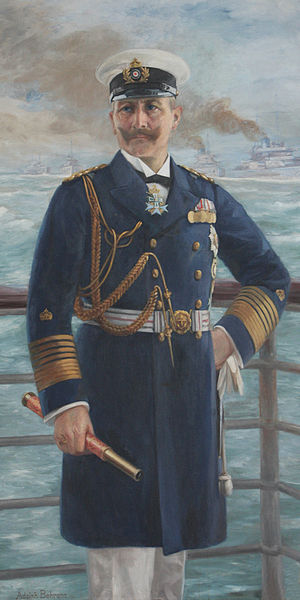 <-(Left: The Kaiser, painted by Adolph_Behrens. The German Emperor was the true driving force behind the origin of the new fleet). Figures are particularly eloquent in this respect: The first Reich was founded in 1870, the then German fleet was limited to a motley collection of units inherited from various Germanic Kingdoms: 5 battleships, 5 heavy cruisers and 4 light. Work on began a first torpedo boat prototype in 1875. Its growth was slow and heavy units built before 1895 were mainly coastguard battleships, like in the Scandinavian fleets. The rise to power of William II in 1890, changed this, as he was significantly less inclined to follow the cautious voice of the famous adviser of his father, Otto Von Bismarck. He was not afraid of a direct confrontation with major powers, at sea as well.
<-(Left: The Kaiser, painted by Adolph_Behrens. The German Emperor was the true driving force behind the origin of the new fleet). Figures are particularly eloquent in this respect: The first Reich was founded in 1870, the then German fleet was limited to a motley collection of units inherited from various Germanic Kingdoms: 5 battleships, 5 heavy cruisers and 4 light. Work on began a first torpedo boat prototype in 1875. Its growth was slow and heavy units built before 1895 were mainly coastguard battleships, like in the Scandinavian fleets. The rise to power of William II in 1890, changed this, as he was significantly less inclined to follow the cautious voice of the famous adviser of his father, Otto Von Bismarck. He was not afraid of a direct confrontation with major powers, at sea as well.
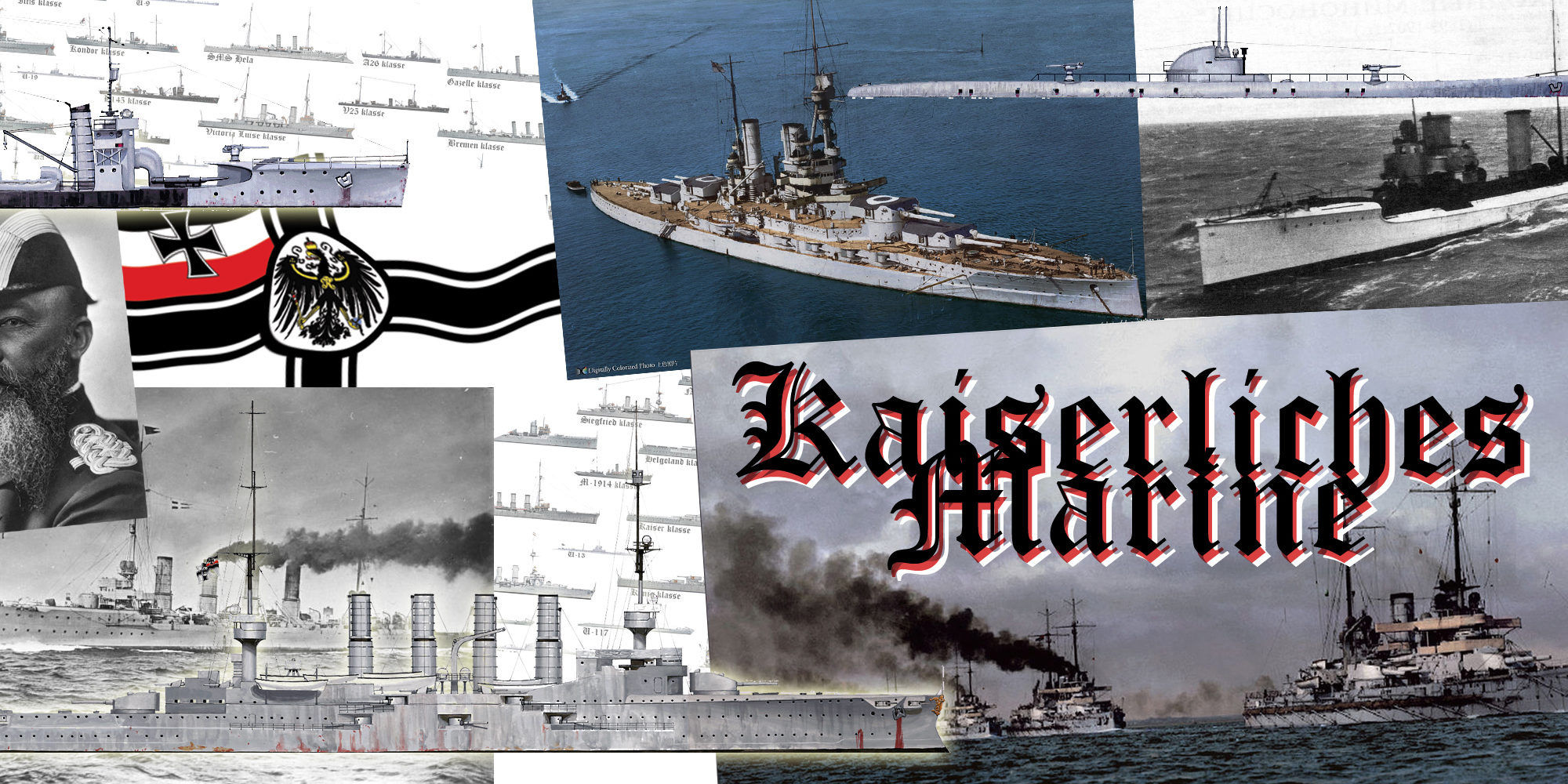
In 1890 there were 13 battleships, 23 Cruisers, 30 TBDs, 15 misc. ships.
In 1914 these figures turned to 47 battleships, 57 cruisers, 143 destroyers, 91 TBDs, about 45 submarines and 6 misc. ships.
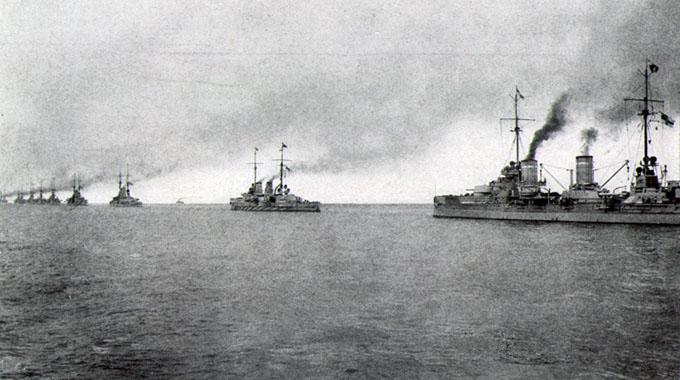
The Hochseeflotte at sea
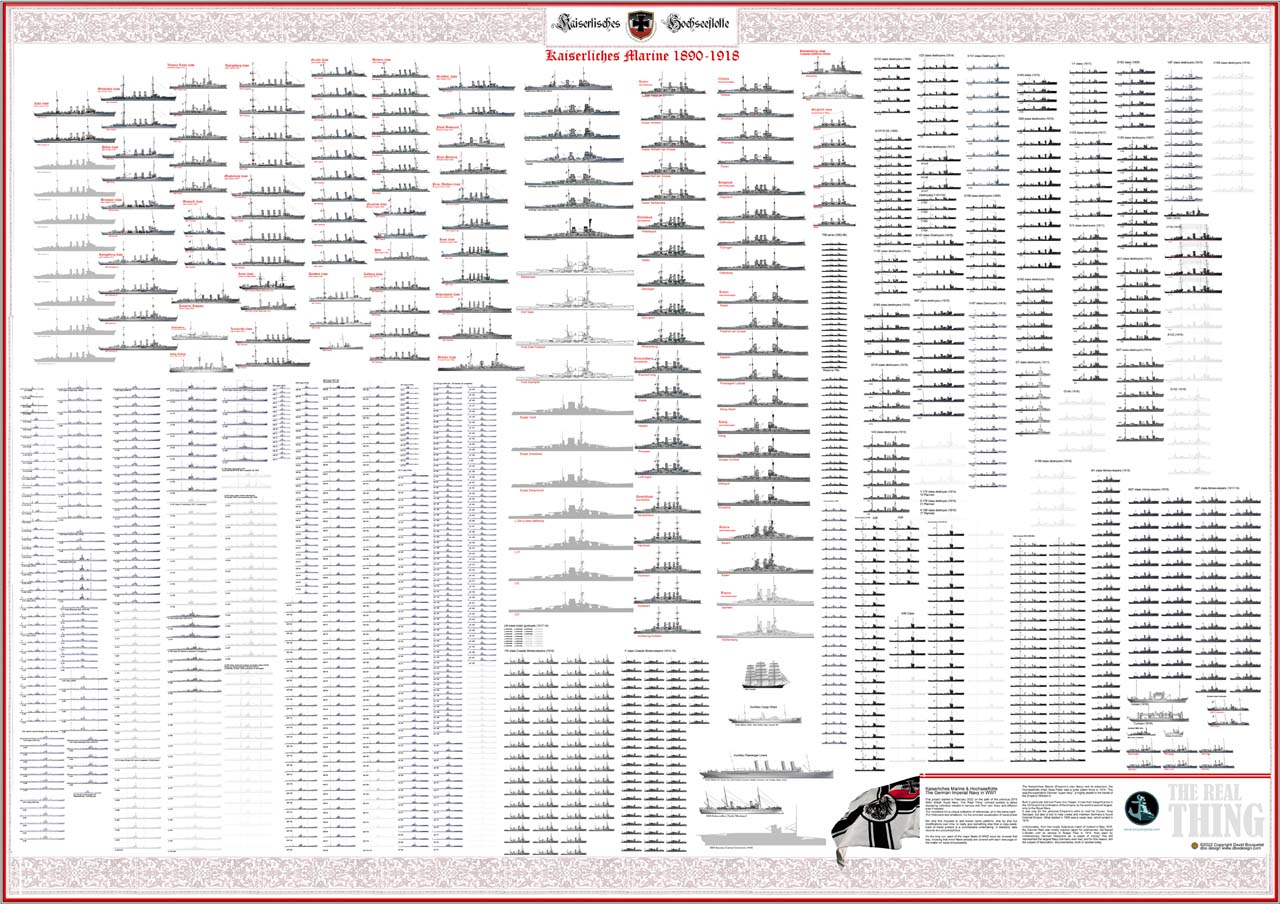
The Kaiserliches Marine in 1914-18: All ships down to the small gunboat launch at 1:700 scale.
Articles Published
- Bayern class battleships (1915)
- Brandenburg class Battleships (1892)
- Braunschweig class battleships (1902)
- Bremen class Cruisers (1903)
- Brummer class cruisers (1915)
- Bussard class cruisers (1890)
- Cöln class cruisers (1916)
- Derfflinger class battlecruisers (1913)
- Deutschland class battleships (1906)
- Dresden class cruisers
- Fürst Bismarck (1897)
- Gazelle class cruisers (1898)
- Graudenz class cruisers (1914)
- Helgoland class Battleships (1909)
- Irene class cruisers (1887)
- Kaiser class Battleships (1911)
- Kaiser Friedrich III class Battleships
- Karlsruhe class cruisers (1912)
- Kolberg class cruisers (1908)
- König class battleships (1913)
- Königsberg (ii) class cruisers (1915)
- Königsberg class cruisers (1905)
- Magdeburg class cruisers (1911)
- Moltke class Battlecruisers
- Nassau class battleships (1906)
- Nautilus class minelayers (1906)
- Pillau class cruisers (1914)
- Prinz Adalbert class armored cruisers (1901)
- Prinz heinrich (1900)
- Roon class armored cruisers (1904)
- Scharnhorst class armoured cruisers (1906)
- Siegfried class battleships (1889)
- SMS Blücher (1908)
- SMS Gefion (1893)
- SMS Hela (1895)
- SMS Kaiserin Augusta (1892)
- SMS Seeadler (1888)
- SMS Seydlitz (1912)
- SMS Von der Tann (1910)
- U1 (1906)
- U13 class (1911)
- U19 class (1912)
- U23 class (1912)
- U3 class (1909)
- U31 class U-Boats (1914)
- U5 class (1910)
- U9 class (1910)
- UB-1 class submersibles (1914)
- UB-II class submersibles (1915)
- UB-III class submersibles (1916)
- UC-III class submersible (1918)
- Victoria Luise class Protected cruisers (1897)
- Wiesbaden class cruisers (1915)
- Wittelsbach class battleships (1900)
- WW1 German Battlecruisers
- WW1 German Battleships
- WW1 German Commerce Raiders
- WW1 German Cruisers
- WW1 German Destroyers
- WW1 German Submarines (U-Boats)
Articles To come
Sachsen class
L20 Alpha (project)
Mackensen class (1917)
Ersatz Yorck class (started)
WW1 German Commerce Raiders (Major Upgrade)
ww1 German gunboats
ww1 German minesweepers
ww1 German TBs
Development of a fleet was a sine qua non condition to the new ambitions of the Reich. Von Tirpitz, appointed secretary of state in 1897, voted the next year the construction of 19 battleships, 8 coastal battleships, 12 cruisers and 30 light cruisers, all of which were pressed into service before 1903. Two years later, the project was extended until 1920, this time including 38 battleships, 14 heavy cruisers, 34 medium and light cruisers, and 96 destroyers.
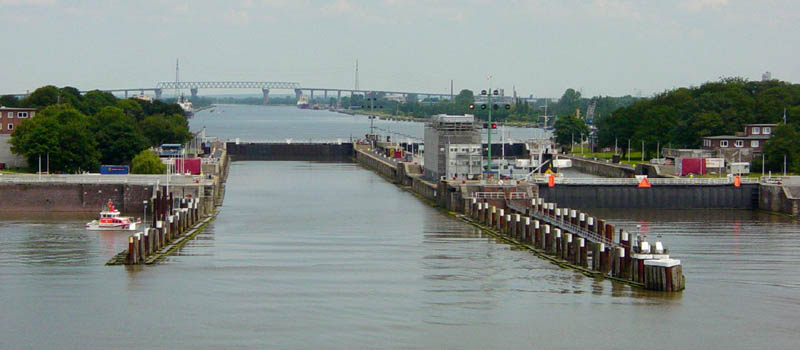
The Kiel Canal sea locks. A vital artery between the Baltic and North Sea for German ships.
This dramatic rearmament plan was basically swapping from a coastal local navy to a global naval superpower. The only comparison nowadays is the formidable rise of the modern Chinese fleet. There were enough programs battleships, Dreadnoughts and battle cruisers to seriously challenge the Home Fleet, after raising an industrial might which in 1910 already surpassed which Britain dominance, making the old Empire to doubt his superiority. This was achieved in just 10 years, and in 1914 the Hochseeflotte arguably reached the world’s second rank. Never in history the German Navy was more powerful at this moment.
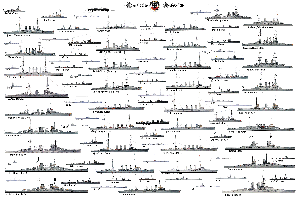
Poster of the German Navy 1914-18
German navy’s strength in 1914
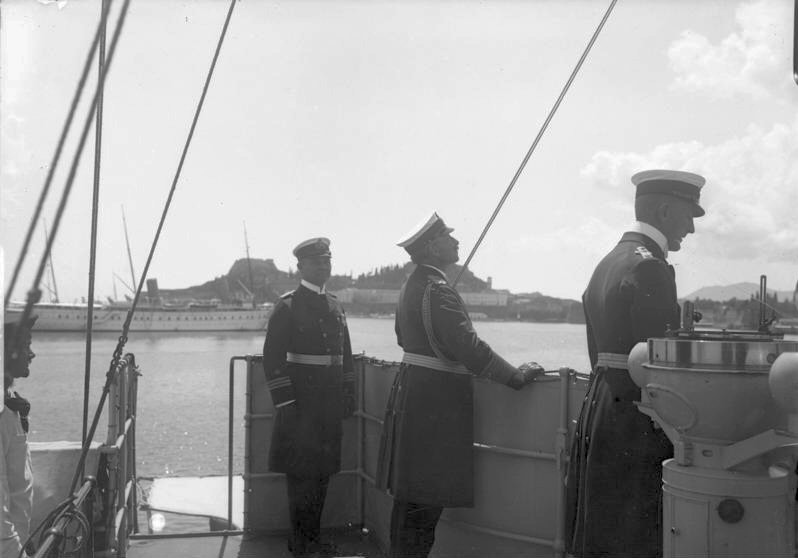
Kaiser Whilhelm II onboard SMS Geier.
29 Pre-dreadnought Battleships
8 coastal battleships of the Siegfried class (1890), 2 Brandenburg class battleships (1891), 4 Kaiser Friedrich III class (1896), 5 Wittelsbach class (1900), 5 class Braunschweig (1902), and 5 class Deutschland.
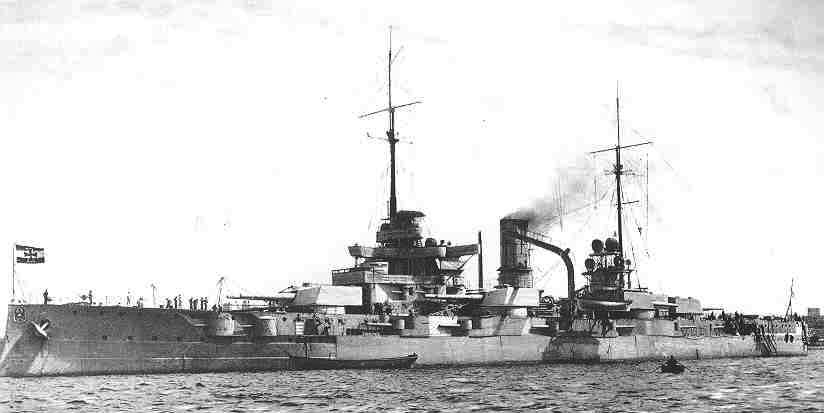
SMS Posen, Nassau class battleships.
13 Dreadnought Battleships
Four classes Nassau (1908), four class Helgoland (1909), and the five Kaiser class (1911). If the Helgoland were basically extended Nassau, the Kaiser class has a new disposition of artillery. It is important to note that these guns were 280 mm (11 inches) in caliber, versus 305 mm (12 inches) standard in the Royal Navy (until the Helgoland class). Kaiser class were the first to introduce 305 mm guns in centerline position and turbines. On the opposite the Royal Navy already swapped to 343 and 356 mm calibers at that time. But German philosophy at that time was to focus on protection at the expense of firepower.
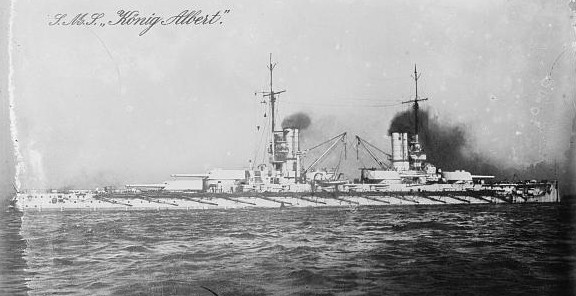
SMS König Albert, Kaiser class battleships
5 Battle Cruisers:
The Hochseeflotte did not displayed as many ships as the Royal Navy (5 units versus 9), but this was the only second fleet to have some: France, the United States or Italy only planned, but never built these ships. These battlecruisers would be always at the forefront of naval operations in 1914-18, largely proving their efficiency. The Blücher (1908) was kind of lightweight copy of Nassau, while the Von Der Tann (1909) has a different arrangement of artillery, and both Moltke (1910) and the Seydlitz (1912) were similar to Kaiser class battleships.
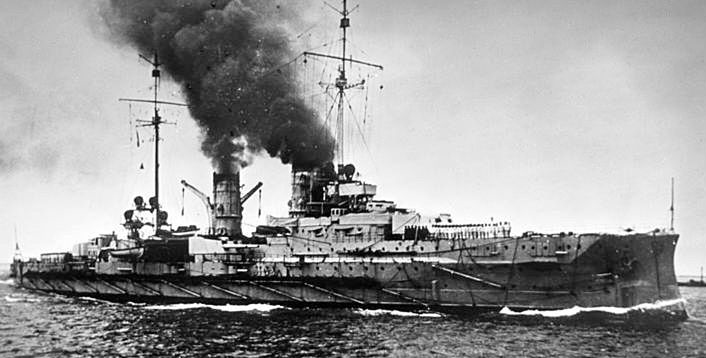
SMS Blücher, first German battlecruiser
47 Cruisers
13 Heavy Cruisers
Heavy cruisers of Hochseeflotte are not only smaller than their contemporary British counterparts (Both Scharnhorst 1906 displaced 12,300 tonnes vs. Warrior/Minotaur classes being over 13 500 tonnes, 6 x234 and 4 x190 mm versus 8 x210 mm and less protection. They did not particularly shine in combat, both Scharnhorst class ships having easy victories in the Falklands in 1914 (the Battle of Coronel). Also were were commissioned much earlier the five Victoria Luise class (1897), Fürst Bismarck (1897), Prinz Heinrich (1900), two Prinz Adalbert class ships (1901) two Roon (1903) and the two Scharnhorst (1906) we saw at the beginning.
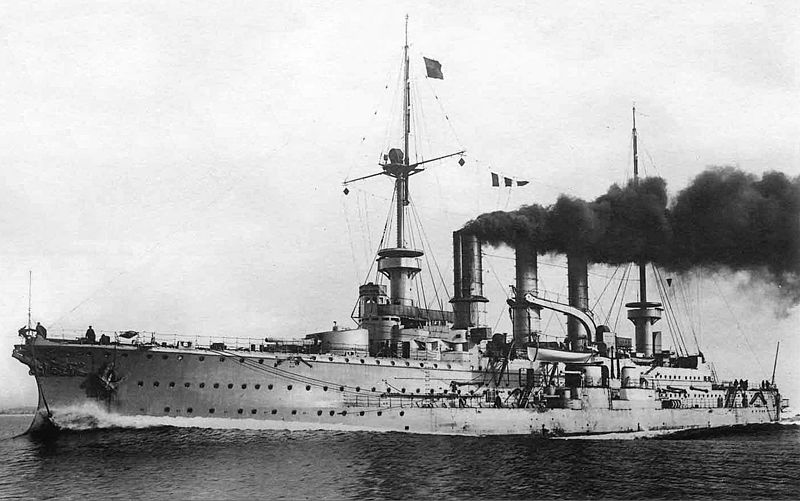
SMS Prinz Adalbert armoured cruiser at full speed
15 Light cruisers (scouts)
Light cruisers included old units like the Gefion (1893), Hela (1895), Kaiserin Augusta (1892), used as patrol or training ships, but also the ten Gazelle (1898-1902), seven Bremen (1903-1905) and the most modern classes of the new programme, Königsberg class (5 units, 1905), Dresden class (2, 1907) made famous in the Pacific, four Kolberg class (1908), four Magdeburg class (1911), two Karlsruhe class (1912), and the two minelayer cruisers Albatros (1907).
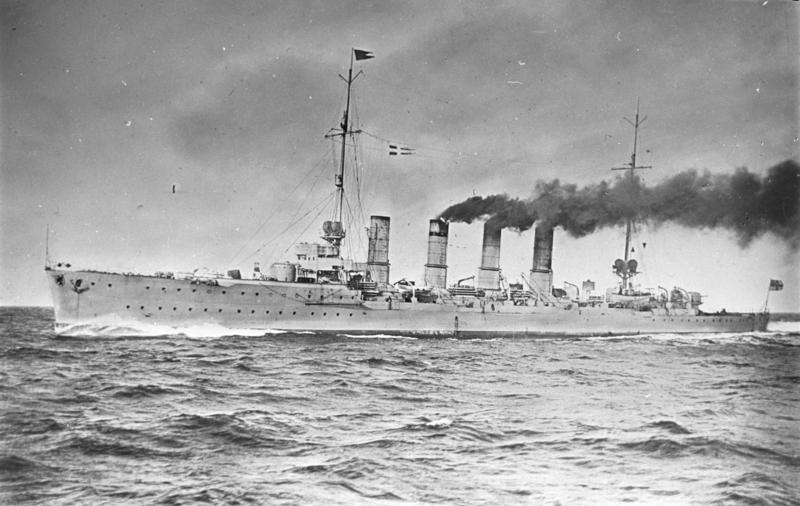
Karlsruhe class cruisers (Bundesarchiv)
143 Destroyers
Until 1915, German destroyers struggled to stand comparison with their British counterparts. Since the launch of Russian destroyer Novik in 1911 a new standard for destroyers appeared in tonnage, autonomy, armament and speed. These new breed of destroyers was also largely driven by the need of flotilla leaders, and made obsolete overnight previous “torpedo boat destroyers” seen like a countermeasure against torpedo boats and still largely coastal and defensive in nature.
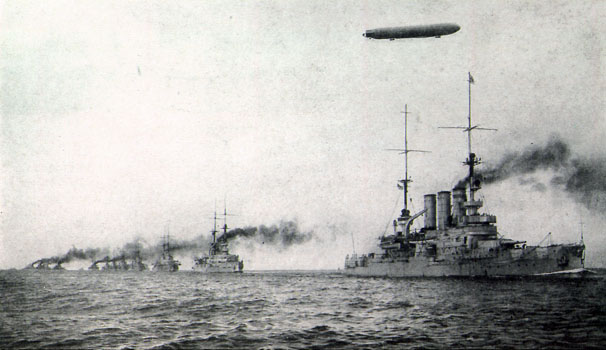
The Hochseeflotte at sea. Quite a formidable force built in a short lifespan, but which remains largely untested.
The British rightly seen with disdain these German “high seas torpedo-boats”, as traduced from German “Hochseetorpedoboote”. They had just enough range to operate with the fleet, but were small enough to be commanded by a single officer -a requirement of Admiral Tirpitz that spoke volumes about workforce shortages in the fleet at that time.
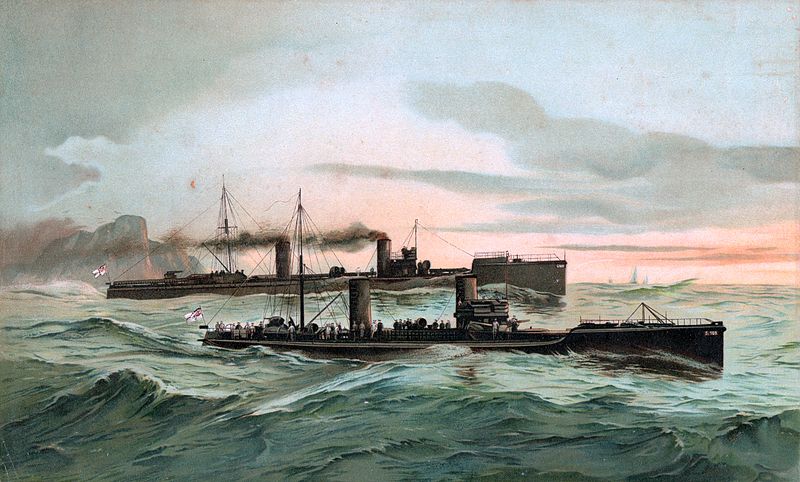
Lithography of G108 and S102
German destroyers, from the 1900 plan were constructed following slices of 6 units per fiscal year, filling a total of eight divisions or fleets. 16 half squadrons were scheduled in total.
The first destroyers dated from 1898. 388 tons ships built by Schichau, preceded by the purchase and study of a single ship purchased from Thornycroft (D10) in 1896. Schichau built 12 of these, and later 6 other improved ones (388 to 400 tonnes): The S90-107 series. Germanierft alternated with 6 G108 (1900).
Then Schichau followed with three groups of 6 units, the S114, 120, 126 series. The S125 (1903) was the largest of them all, a prototype announcing the 1905-06 ships. She was followed by the S138 class (12, 1906), Germaniawerft delivering its G132 and G137. (6 ships). Vulcan AG received an order for 10 other vessels (V150 class) and launched the large V161 prototype in 1908. She was followed by three V162 (1909), eleven V180 (1909), six V1 (1911), and six V25 (1914). Schichau in turn launched the four S165 (1910), four S176 (1910), twelve S13 (1911), six S31 in early 1914. Eventually Germaniawerft completed these series by nineteen G169, G192, G7 series in 1908-1911.
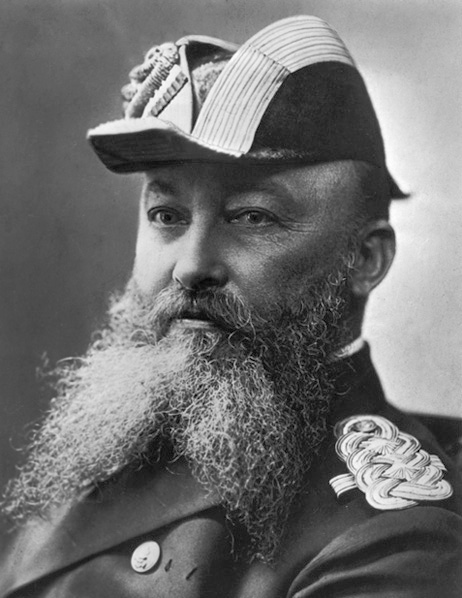
Admiral Von Tirpitz, the grand designer of the Hochseeflotte.
91 Torpedo Boats
Hochseeflotte’s TBDs were maintained in service, despite dating back from 1886-1898. All built by Schichau (ex-T11-T65 “S” and T66-89), except for two G88 and 89 by Germaniawerft. They were led by “flotilla leaders” large coastal TBDs also built by Schichau between 1886 and 1894 (D1-9). Second class T11-65, T66-89 first class).It must noted that Schichau built four destroyers for China in 1898, returned after their capture in 1900 during Allied operation against the forts of Taku. therefore, one of theses remained in service under the same name Taku in the German flotilla located at Tsing Tao, lost by bombing of the Japanese in 1914.
45 Unterseeboote
German subs who were to play a great role in the Great War. The came all the way back from the U1 (1906), but going further back into the past we find the Brandtaucher, built by famous Bavarian engineer Wilhelm Bauer in 1850, lost during his first dive. He did not convinced the authorities despite the improvements made and it was not until 1891 that a new prototype was tried without success by Howaltswerke, in 1897. In 1902, former assistant of engineer Laubeuf, Spanish-Ecquevilley of Montjustin, was hired by the Friedrich Krupp yard (Germaniawerft) in Kiel. The Forelle, first model conceived by the new team was largely inspired by the French Narwhal, and excelled at export (3 “Karp” for Russia, U3 and U4 for the Austro-Hungarians, Norwegian Kobben).
However Von Tirpitz paid little attention to this type of unit, until an inspection report showing the immense possibilities of this new weapon. He then approved the construction of U1 at Germaniawerft. Imperial arsenals OF Kiel, also received order for the the U2 in 1908. But the departure of the Spanish engineer brought the two yards to reevaluate the design as the U3, from two studies (1909, built in Danzig). Danzig and Germania Yards shared the following U5 (4 units), U9 (4), U13 (3), U16 (7), U17 (2), U19 (4), U23 (4), U27 (4), U31 (11), at the end of 1913. Approximately 40-47 in total were in service in 1914. The mass production would start a little later during the conflict.
6 Miscellaneous
Gunboats were a few, because of the weakness of German colonial possessions worldwide. Nonetheless, three mixed colonial gunboats (sailing corvettes) class Wolf (1878), Habitch (1879), Hay and Eber (1881-1887), were in service as well as steam gunboats Iltis class (6 ships 1898), and the river gunboat Otter (1909), based in China.
Videos about the Kaiserliches Marine and Hochseeflotte, the German Imperial Navy:
Scuttling of Scapa flow 1919 documentary
German Naval Aviation:

Sablatnig SF5 fighter
The Luftreitskrafte already operated during WWI the following:
-Albatros W.4 floatplane fighter (1916)
-Albatros W.8 two-seat recce floatplane (1918)
-Friedrichshafen FF.29 to FF.59 floatplanes (bombers, torpedo, recce)
-Gotha WD.1-27 multirole floatplanes
-Hansa-Brandenburg series
-L.F.G V.19 Stralsund submarine floatplane (1918)
-L.F.G W (navalized Albatros C.Ia, 1916)
-L.F.G WD (navalized LFG Roland D.I, 1917)
-Lübeck-Travemünde F.1-F.4 floatplanes (1914-17).
-Oertz W 4-5-6-8 (12+4 in all, by Hamburg Yacht Cie)
-Rumpler 4B 11 – reconnaissance floatplane (1914)
-Rumpler 4B 12 (recce floatplane, 1914)
-Sablatnig SF-1-8 single/two-seat floatplane (1916-18)
-Zeppelin-Lindau Rs.I-IV – patrol flying boat (1916-17)
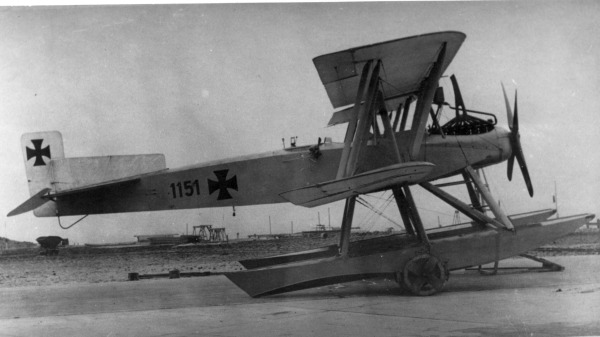
Lübeck-Travemunde F2, Ray Wagner Coll.
Early German Battleships
Wittlesbach class -The “Länder” Battleships
The “Regions” derived from ancient elective kingdoms responsible for the head of the ancient Holy Roman Empire, were the first serie of two relatively similar pre-dreadnought classes
They had been ordered in the FY1898 budget instituted by Von Tirpitz, then Minister of the Navy. They were quite close to the previous Kaiser, but some of their secondary turret artillery had been replaced in barbettes.
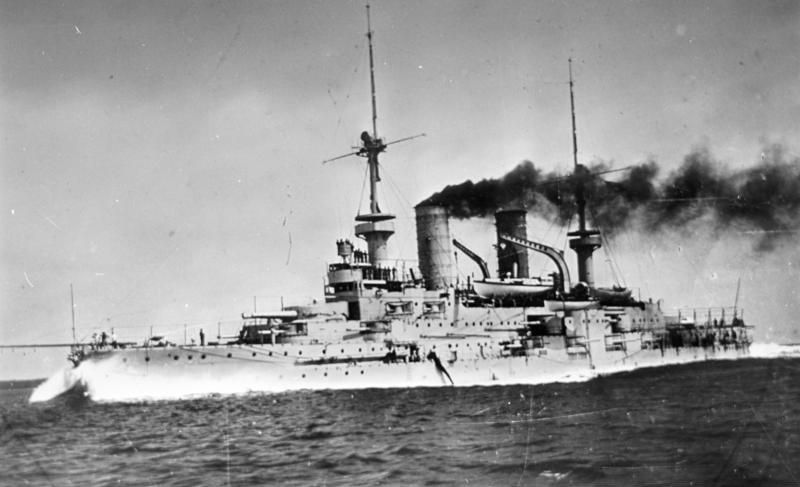
Design
The new design was prepared by Prof. Dr. Dietrich, chief constructor of Kaiserliche Werft Wilhelmshaven, which lobbied to keep the same armament despite insitance by Konteradmiral Emil Felix von Bendemann to swp to 280mm guns.
The Kaiser’s design lessons were also digested in terms of superstructure height and stability. The hull was more like a continuous bridge. As for the Kaiser, the front turret was resting on a battery bridge, overlooking the front deck. Another change was the belt that was reinforced and more extensive on the vertical plan.
The speed was increased by half a knot. The hull was also heavier and much wider. For close-quarter combat, the ships were equipped with six 45 cm (17.7 in) torpedo tubes, above-waterall with swivel mounts.
The torpedoes 87.5 kg (193 lb) TNT warhead could reach the enemy at 26 knots or 32 depending of the settings. This made for a shorter range, from 800 to 500 m.
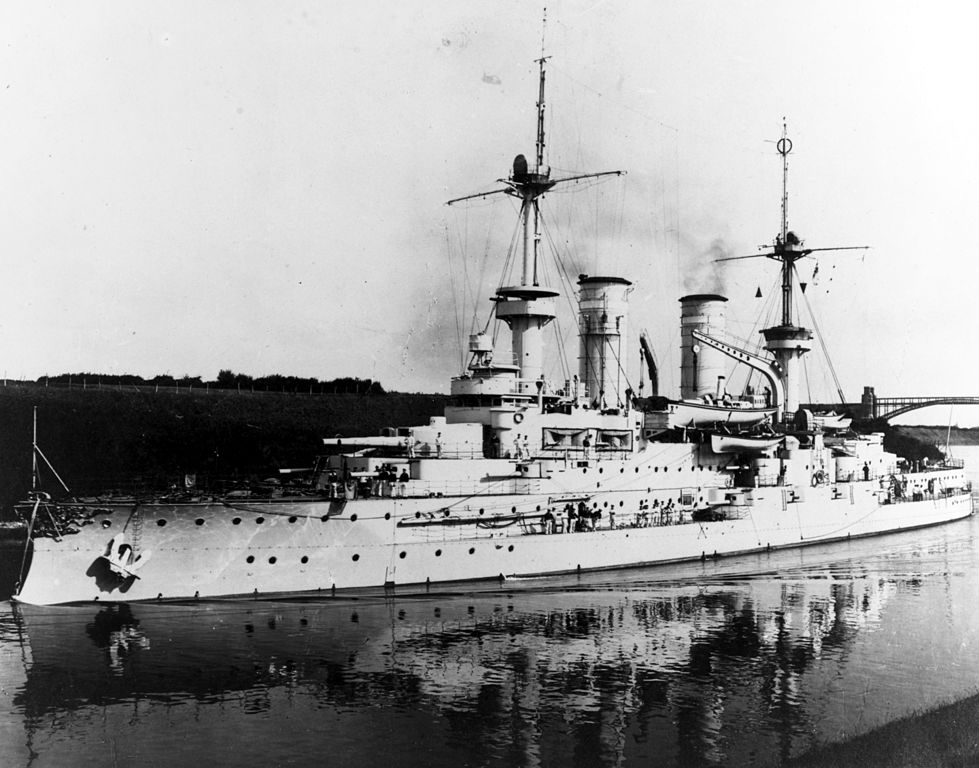
Armament
The main armament comprised four 24 cm (9.4 in) SK L/40 guns in twin gun Drh.L. C/98 turrets, which allowed elevation to 30° and depression to −5°. Range was 16,900 meters (18,500 yd). They can fire a 140-kilogram (310 lb) shell at 835 meters per second (2,740 ft/s), with 85 in store for each gun.
Secondary battery comprised eighteen 15 cm (5.9 inch) SK L/40 guns. Four in single turrets and the rest in casemates. They were fast-firing at 4–5 per minute, with 120 rounds in store. These rounds could be fired up to 13,700 m (14,990 yd) and weighed 51kg (112 lb), leaving the muzzle at 735 m/sec. (2,410 ft/s).
In casemates and pivots were also mounted twelve 8.8 cm (3.45 in) SK L/30 quick-firing guns to deal with torpedo boats. Their high rate of fire was about 15 rounds for a trained crew.
All were 7.04 kg (15.5 lb), leaving the muzzle at 590 mps (1,936 fps). They were capable to hit a target in maximal elevation at 6,890 m (7,530 yd).
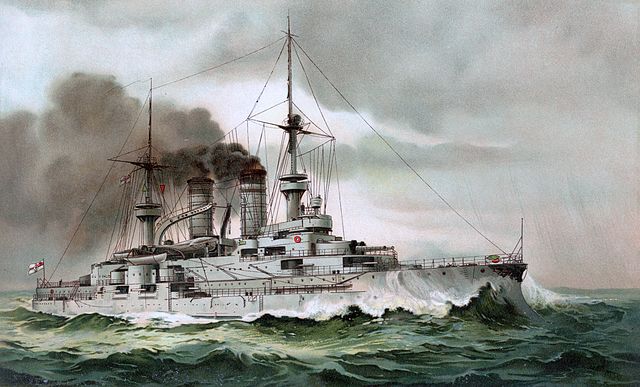
Protection
The ships were given Nickel steel made by Krupp. Decks were 50 mmm (2.0 in) thick, with sloped sides (up to 120 mm (3.0 to 4.7 in)) connected it to the main armored belt.
The latter was 225 mm (8.9 in) in the central section which covered ammunition magazines, propulsion system and command organs. It was reduced to 100 mm (3.9 in) on either end while the the bow and stern were not protected at all.
This belt was backed by 100 mm of teak planking. Casemate guns were protected by 140 mm (5.5 in) steel plates while the secondary turrets turrets were sides were increased to 150 mm (5.9 in), while gun shields were 70 mm (2.8 in) thick.
The main turrets were 250 mm (9.8 in) thick with 50 mm roofs. The forward conning tower had the same thickness but rear one was only 140 mm thickwith a 30 mm roof.
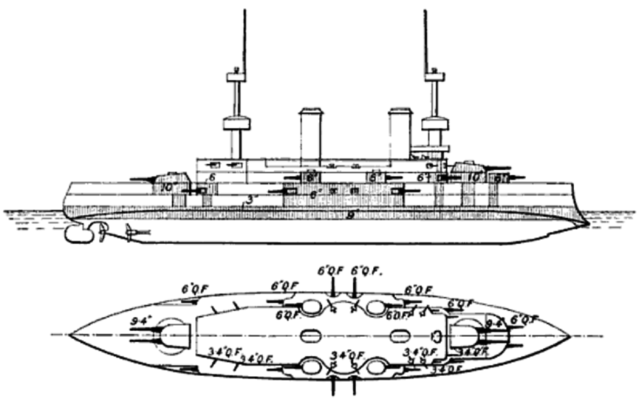
Career
In 1914 they were assigned to IV Battle Squadron deployed to the Baltic, based in Kiel. Until 1916 they were kept in reserve, making rare sorties and limited duty in the Baltic Sea against the Russian Navy. Under command of Vice Admiral Ehrhard Schmidt.
In early September 1914, a sweep was conducted against the Russian navy, without encounter. In May 1915, four of the Wittelsbachs bombarded Libau, a preparatory operation for a landing there by German troops.
The were stationed there by the time of the Battle of the Gulf of Riga in August 1915 but did no fired a shot.
Judged obsolete and too vulnerable to submarines that took their toll already against many faster cruisers, they were never really engaged. In 1916 they were reassigned to subsidiary roles, being withdrawn from active service and disarmed by 1916: The Mecklenburg became a floating prison, the others served as training ships.
In 1919, the Wittlesbach (and Braunschweig-class Lothringen) were converted into minesweeper depot ships, motherships for ten F-type units stored on their restored bridge. The experiment ended in 1921. She served then as a floating barrack, and was later striken and broken up.
The others shared this fate except Zähringen, which was converted in 1926 into a radio-controlled target. She served into this role until December 1944: Anchored in Gdynia, she was bombed by the RAF and what left broken up by the Germans after the war in 1949-50.
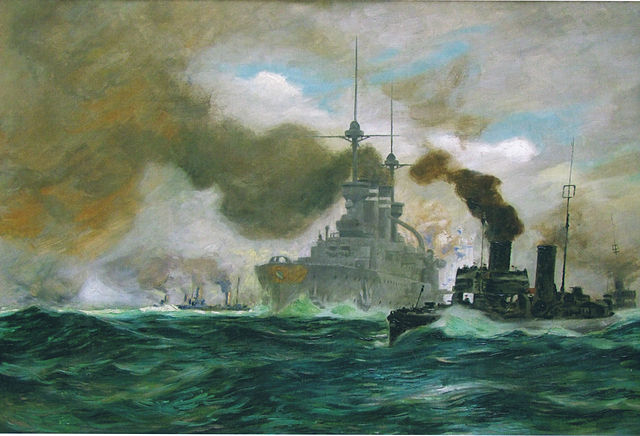
SMS Zähringer in manoeuvers
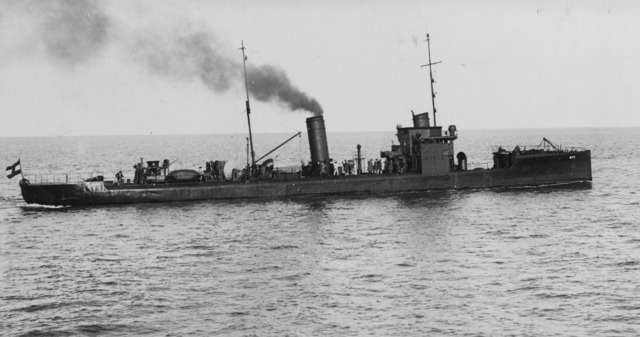
Radio Contol ship Blitz, operating the Zähringen
Early German Cruisers
SMS Gefion was the oldest German cruiser in service when the war broke out in August 1914, but not really listed as active.
German oldest ‘Cruiser’ prior to 1914
In 1900, the German Navy still possessed fairly old ships in various preservation state, which not could be possibly modernized: The last four of the Bismarck class iron flush-decked corvettes (1875-78), BLücher, Stoch, Moltke Gneisenau and Stein were still active as school ship. Gneisenau would be wrecked in 1900 and the other hulked, BU or sold in 1907-1910. Lighter ships of the Carola class (1879), Nixe (1883), Charlotte (1883), were still fully rigged ships, discarded and BU 1906-1911.
The term “Kreuzer” (Cruiser) was used for the first time however on the SMS Schwalbe class ships (1887). However they fallrather in the category of colonial sloops. They were barquentine-rigged and only 1337 tons in displacement. Sperber BU in 1912 while Schwalbe ended as an unnamed harbour ship in 1911 and survived the great war. The next light cruiser class however partially saw service in WW1: These were the Bussard class (1888-1893), composed of the Bussard, Falke, Seeadler, Condor, Cormoran and Geier. Still in the same style or rigged “gunboats” in international standards, they were larger at 1840-80 tons but served indeed as gunboats during WW1. The first two were discarded in 1913, two more were hulked in 1914, while Cormoran was scuttled in Tsingtao, and Geier was captured by the USN in 1917.
Next, the Irene II class were considered protected cruiser-corvette of second class. They were in fact, the very first true German Cruisers. Not rigged like previous ships and with a displacement of 4974 tons these 1886 ships were cruisers through and through. Both served in WW1, Irene as an U-Boat depot ship from 1914 whereas Pinzess Wilhelm was a minehulk in 1914, barely active roles.
Not long after was built the SMS Kaiserin Augusta (1890), an even larger protected cruiser, followed by a serie of “heavy cruisers” which were in fact the first German armoured cruisers, of the Victoria Luise class (1896). In parralel the lineage of German rigged avisos such as Zieten and mixed Blitz class, Geif, Wacht and Meteor classes were no longer active in WW1 (see German avisos). The first “light cruiser” of the German Navy was denominated a Cruiser-Corvette of the 3rd class: SMS Gefion.
By all standards, she was the oldest active cruiser in the German Navy when the war broke out.
Development and design of HMS Gefion
Developed in parrallel to the Kaiserin Augusta and after the Irene class (1886), she was very much a transitional ship and prototype of cruiser. She was orginally planned to carry 150 mm guns but it was later too optimistic given her dimensions and light construction. She would have been unstable. Instead, she was equipped with twice lighter 105 mm guns. She did had a protective deck, ranging from 25 to 40 mm in thickness and was wood-sheated.
She was a 4208 tons standard ship, 110 m in length for 13.2 in width and 6.47 in draft, with a flush-deck hull, turtleback on front, and central lower fighting deck on which were placed her battery. Her ten 105 mm guns were placed in pairs forward and aft, and the remainder six on the broadside, two aft and close together and the third pair further forward, amidships between the first and second funnel. Her anti-torpedo boat armament comprised six 50 mm QF guns, of which two were placed the stern cutouts, a pair between the two aft broadside 105 mm guns and two abreast the second funnel. She was also given two 450 mm torpedo tubes (broadside).
Gefion was given two shaft propellers connected to Triple Expansion engines, rated for a total of 9000 hp, and top speed of 19 knots. This was not blazing fast for a scout cruiser but still average in the 1890s for a cruiser. Complement was 302 officers and sailors.
Active service
SMS Gefion was completed in June 1894, built at Schichau, as specialist of rather smaller ships. She served without notable incident until 1901 when she was taken in hands for a modernisation which lasted until 1904. When out she was placed in reserve. She participated in WW1 in partial service because of shortages of manpower under Corvette Captain Waldeyer. She was completely inactivated in 1916 when her crew was affected on other ships, she sailed to Danzig for the last time and was used as a barrack ship from then on until the end of the war.
After the war ended there were discussions to sent her to shipbreakers to respect tonnage restrictions, but instead she was sold to the civilian market and converted as a merchantman, a task she had been hardly created. This was due to the dire shortage of commercial shipping Germany faced at that time. She served for three years as Adolf Sommerfield before being broken up.
War programme (1914-18)
Although volumes were lower for heavy units (battleships and battle cruisers), there was nonetheless a considerable ongoing production effort although still inferior the UK or the US, at their peak from 1917. The most formidable weapon aligned were by far the Unterseeboote, which quickly became instrumental to fold Britain’s resolution by severing all its trade and supply network.
6 new Battleships (Schlachtschiffe)
This were Dreadnoughts, follows-up in the Tirpitz plan. The first were of the König class (4 units, launched in 1914, September, and January-February 1915, completed in 1915-1916). They had a new artillery arrangement, 10 x305 mm in with a central turret centerline, like the British units King George V, Orion and Iron Duke. However the latter had stepped up to the caliber 343 and 356 mm.
With both Bayern and Sachsen classes, the caliber 380 mm was adopted directly, like the Queen Elizabeth and Resolution, in four twin turrets. These ships are a common design, and the best and last German battleships to be built before the record-breaker Bismarck and Tirpitz 1940-41 which shared many similarities.
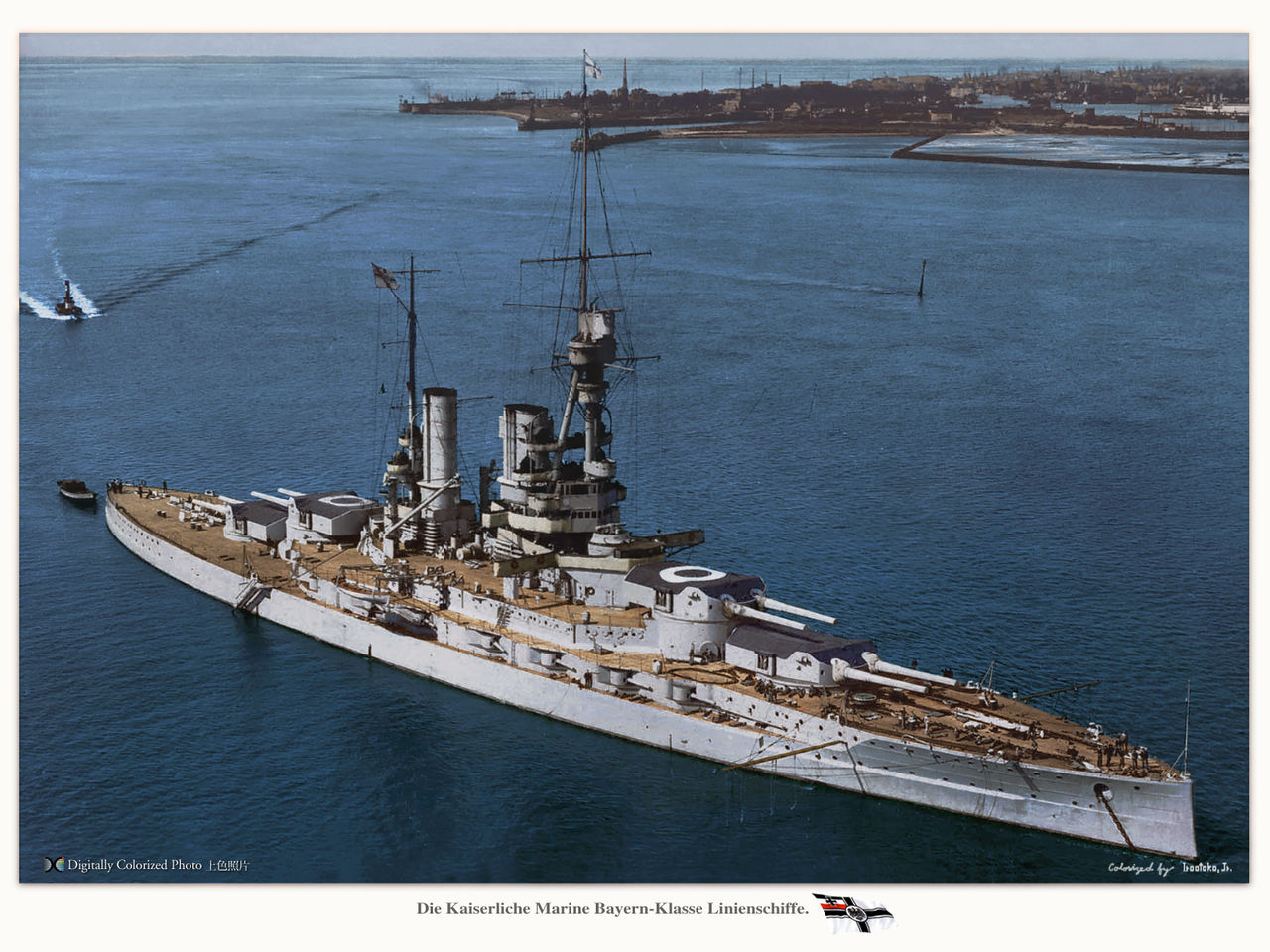
Digitally-colorized photo of the Bayern in 1918.
Bayern and Baden were launched in 1915 and completed in June 1916 and February 1917. They never took part in the famous battle of Jutland. Sachsen and Würtenberg were launched in November 1916 and June 1917 and scheduled for completion in 1918, but work was delayed and later abandoned.
It was also planned a new generation of “fast” battleships (26 knots against Bayern’s 21), L20 Alpha project, which exceeded 50 000 tonnes and were armed with 420 mm cannons. Their construction started before September 11, 1918 and was shortly halted. What-if German ships lover could only imagine if they would have ended in service with the Kriegsmarine, fully modernized, alongside the Bismarck class.

HMS Sachsen class Battleships blueprint (cdts https://www.sms-navy.com).
4 new Battlecruisers (Große Kreuzer))
The last German battlecruisers are nowadays considered by experts to have been the best ever designed, an example to many marines for their fast battleships of the 1930s. The British themselves have the Hindenburg sunk at Scapa Flow in 1919 refloated for a close and detailed examination by the Royal naval engineers corps. The ships excellent protection was superbly demonstrated at Jutland, and can be considered now as the ancestors of the “super-dreadnoughts” of ww2.
Seydlitz was commissioned during the war and was the last featuring a long forecastle, while the next two Derrflinger, launched in 1913 and completed in November 1914 and March 1916 had a flush-deck. These ships were the largest and most powerful of their kind in service at 30 000 tonnes of displacement. The Hindenburg was launched in August 1915, completed in October 1917, and was a sort of follow-up. However, it was slightly larger, faster, and even much better protected.
The Hindenburg is the prototype of the Mackensen class, consisting of 4 new “heavy battlecruisers” started in 1915 and launched in 1917 but never completed because of the armistice. These were significantly larger had a full 350 mm artillery caliber. Other projects of this period are even more impressive, designed to answer the British Repulse: The Yorck class was to have three ships built, of which only the first was launched in July 1916 but also abandoned. They displaced 39 000 tonnes for 8 x380 mm in twin turrets, fast battleships equivalents of the 1917 Baden and Bayern.
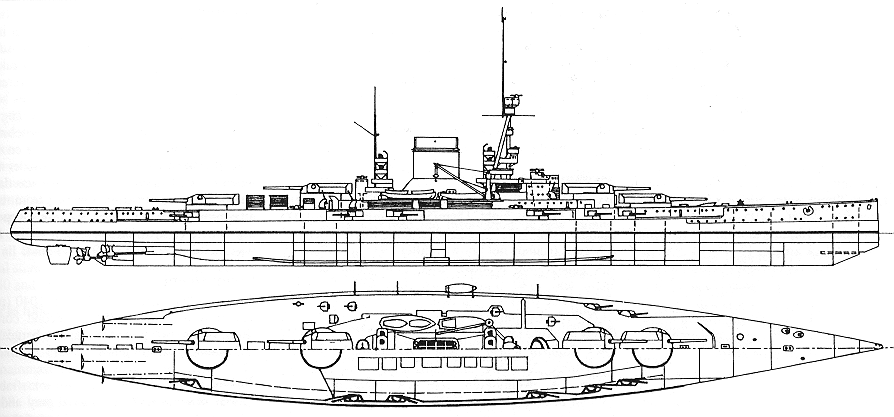
SMS Ersatz Yorck class battlecruisers line drawing (1917 project).
14 new cruisers
Only light cruisers would be built: The two Graudenz (1914-1915), two Pillau (1914-1915), two minelayers Brummer class (1916), two Wiesbaden class (1915), four Königsberg-II (1915-1916), and two Cöln-II (1918). The latter were a step ahead with 7,500 tons fully loaded, 155 meters long and armed with 8 x 150 mm guns. The last two classes were named after units lost at the beginning of the conflict. The Cöln class originally was to include ten ships, but only two were completed on seven launched.
About 60 new destroyers
Production of Destroyers resumed with a shifting towards the end of the war to larger British and Russian standards. In 1915, a somewhat atypical serie class B 97, is designed for the Russian fleet at St. Petersburg yard, which subcontracted Blohm and Voss in Hamburg. Of course in August 1914, the four Russian units were seized and completed with German standards for incorporation. Almost twice as heavy as other units in service they were also the only ones officially called “Destroyers” (Zestörer). The G 101s were of the same ilk, but designed for the Argentine navy and also incorporated. Not until 1918, with the class S-113, the first true German destroyers were built. Many of their successors were never completed.
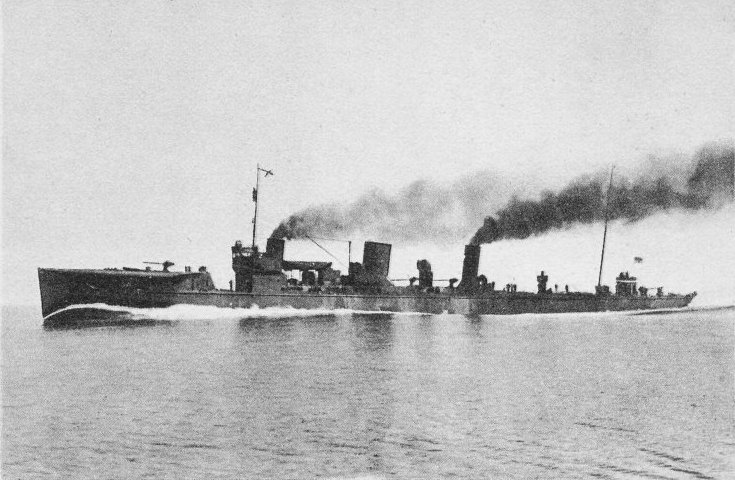
SMS V-99 (V-97 class). Originally ordered by Russia, this requisitioned class of unusually large destroyers served as flotilla leaders.
80 new TBs
For torpedo boats, about 80 were built for coastal service, class A 1 to A 56, via the A 26, consistent with older destroyers in service.
They saw an active service on the Belgian Coast.
370 U-boats
The strength of German U-boats at sea constituted the backbone of the German fleet efforts in the Atlantic, but soon also on all seas. This success was due to a staggering 370 units commissioned during the conflict (a straw compared with 1400 in the second World-War) but the allies lack of organization at the beginning of the war led to unsurpassed results for German submariners. U-boats eventually failed to suffocate the British Empire, despite a restriction-free submarine warfare in February 1917, but they neverthless had successes, hunting scores unparalleled with ww2. Lothar Von Arnaud de la Périère was an “ace”, scoring 194 kills, about 454 000 tonnes, but also famously U9 (commander Weddingen), that sent to the bottom in less than an hour the British armoured-cruisers Hogue, Cressy and Aboukir.
12.427 million tons of shipping were indeed sent to the bottom until November 1918, of which 12.404 million for Great Britain alone. At the height of the “first” Battle of the Atlantic, between 60 and 90 U-Bootes were operating simultaneously, and between 178 and 199 were lost in action.
Note also that a large proportion of submarines, namely UB and UC classes, were small coastal submersibles capable of laying mines but unsuitable to long cruises in the Atlantic, reserved for the oceanic models.
War shipbuilding:
Battleships 19
Cruisers: 14
Destroyers: About 60
Torpedo Boats: 80
Submarines: About 370
The Hochseeflotte in action
How was used this formidable weapon, the most powerful ever fielded by any continental European country before the Soviet Navy in the 1960-1990s ? Already the very night of the hostilities starting in august with declaration of war, major estuaries were mined in a pretty bold and very risky move by converted auxiliary cruiser Königin Luise.
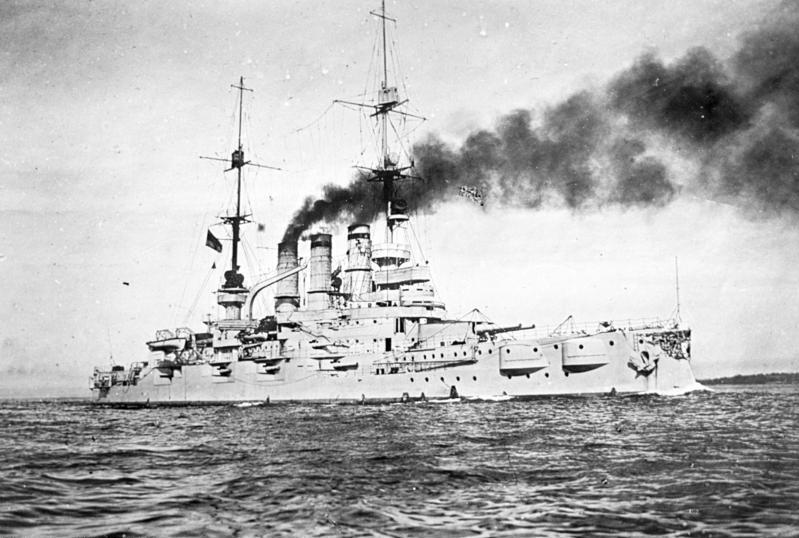
German pre-Dreadnought Battleship SMS pommern.
In the Mediterranean, the Goeben and the Breslau had to escape the combined patrold of the Royal Navy, French and Italian navies. Gibraltar controlling access to the Atlantic, Admiral Souchon, Goeben’s commander and its brand new large battle cruiser had no hope to force its way to the Atlantic and back to Germany from Port Said (Egypt). For Egypt and the Suez Canal were also locked and any attempt to rally Von Spee through the Indian Ocean and the Pacific was doomed. Only remains desperate solutions, either fight or find refuge in friendly waters thos of allied Ottoman Empire. What was hailed as a feat later saw the Goeben escaping her pursuer and entering the Bosphorus to rally the Black Sea and Constantinople harbour. There, the two ships swapped flag, the Goeben officially renamed Yavuz Sultan Selim until the end of the war.
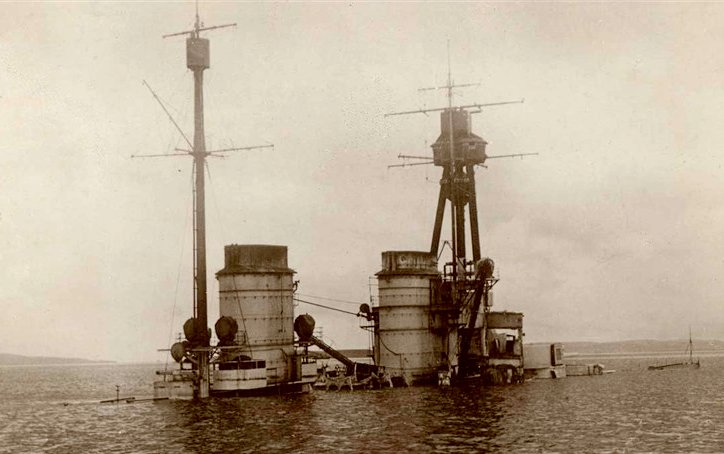
SMS Hindenbug scuttled at Scapa Flow, 1919.
Eventually the German Pacific fleet in Tsing Tao, under the command of Admiral Von Spee, also secured his men’s salvation by ordering a hasty departure from the base, under the threat of combined Japanese, Russian and British fleets. Von Spee in addition had relatively old ships at his disposal but nevertheless masterfully used them, gaining success by decimating the Falklands squadron (admiral Cradock) before succumbing to superior British forces (2nd battle of Coronel). The Emden separated from the squadron to lead a memorable corsair war, diverting pursuers (a true Odysseus). In Africa, the port of Dar-el-Salaam was an advanced base for German colonization, under the sword of Damocles of the Allied forces. The Königsberg will also lead a privateer war, with less success than in the Pacific.
Read More/Src:
Conway’s all the world’s fighting ships (3 editions 1865-1947)
On wikipedia
https://www.kaiserliche-marine.de
https://www.sms-navy.com/
https://www.worldwar1.co.uk/
https://www.navweaps.com/

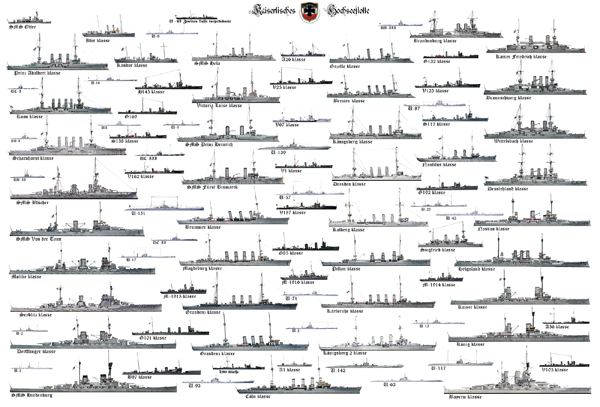

 Latest Facebook Entry -
Latest Facebook Entry -  X(Tweeter) Naval Encyclopedia's deck archive
X(Tweeter) Naval Encyclopedia's deck archive Instagram (@navalencyc)
Instagram (@navalencyc)





 French Navy
French Navy Royal Navy
Royal Navy Russian Navy
Russian Navy Armada Espanola
Armada Espanola Austrian Navy
Austrian Navy K.u.K. Kriegsmarine
K.u.K. Kriegsmarine Dansk Marine
Dansk Marine Nautiko Hellenon
Nautiko Hellenon Koninklije Marine 1870
Koninklije Marine 1870 Marinha do Brasil
Marinha do Brasil Osmanlı Donanması
Osmanlı Donanması Marina Do Peru
Marina Do Peru Marinha do Portugal
Marinha do Portugal Regia Marina 1870
Regia Marina 1870 Nihhon Kaigun 1870
Nihhon Kaigun 1870 Preußische Marine 1870
Preußische Marine 1870 Russkiy Flot 1870
Russkiy Flot 1870 Svenska marinen
Svenska marinen Søværnet
Søværnet Union Navy
Union Navy Confederate Navy
Confederate Navy Armada de Argentina
Armada de Argentina Imperial Chinese Navy
Imperial Chinese Navy Marinha do Portugal
Marinha do Portugal Mexico
Mexico Kaiserliche Marine
Kaiserliche Marine 1898 US Navy
1898 US Navy Sovietskiy Flot
Sovietskiy Flot Royal Canadian Navy
Royal Canadian Navy Royal Australian Navy
Royal Australian Navy RNZN Fleet
RNZN Fleet Chinese Navy 1937
Chinese Navy 1937 Kriegsmarine
Kriegsmarine Chilean Navy
Chilean Navy Danish Navy
Danish Navy Finnish Navy
Finnish Navy Hellenic Navy
Hellenic Navy Polish Navy
Polish Navy Romanian Navy
Romanian Navy Turkish Navy
Turkish Navy Royal Yugoslav Navy
Royal Yugoslav Navy Royal Thai Navy
Royal Thai Navy Minor Navies
Minor Navies Albania
Albania Austria
Austria Belgium
Belgium Columbia
Columbia Costa Rica
Costa Rica Cuba
Cuba Czechoslovakia
Czechoslovakia Dominican Republic
Dominican Republic Haiti
Haiti Hungary
Hungary Honduras
Honduras Estonia
Estonia Iceland
Iceland Eire
Eire Equador
Equador Iran
Iran Iraq
Iraq Latvia
Latvia Liberia
Liberia Lithuania
Lithuania Mandchukuo
Mandchukuo Morocco
Morocco Nicaragua
Nicaragua Persia
Persia San Salvador
San Salvador Sarawak
Sarawak Uruguay
Uruguay Venezuela
Venezuela Zanzibar
Zanzibar Warsaw Pact Navies
Warsaw Pact Navies Bulgaria
Bulgaria Hungary
Hungary

 Bundesmarine
Bundesmarine Dutch Navy
Dutch Navy Hellenic Navy
Hellenic Navy Marina Militare
Marina Militare Yugoslav Navy
Yugoslav Navy Chinese Navy
Chinese Navy Indian Navy
Indian Navy Indonesian Navy
Indonesian Navy JMSDF
JMSDF North Korean Navy
North Korean Navy Pakistani Navy
Pakistani Navy Philippines Navy
Philippines Navy ROKN
ROKN Rep. of Singapore Navy
Rep. of Singapore Navy Taiwanese Navy
Taiwanese Navy IDF Navy
IDF Navy Saudi Navy
Saudi Navy Royal New Zealand Navy
Royal New Zealand Navy Egyptian Navy
Egyptian Navy South African Navy
South African Navy






























 Ukrainian Navy
Ukrainian Navy dbodesign
dbodesign